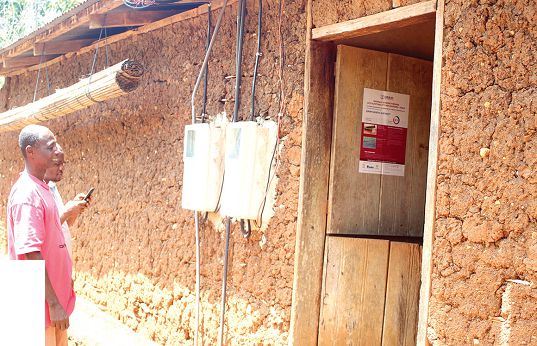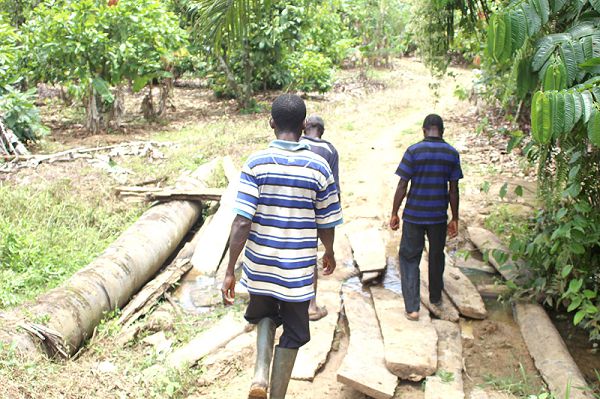
Light shines on famous 4 bearing names referencing genitals
Four communities in the Birim North District in the Eastern Region earned national fame a year ago when their uniquely funny names that reference genitals were amplified by the media as their sorry story of poverty and deprivation was told.
A year on, their connection to the national grid has enlightened their homes and lives, changing some aspect of their story.
Advertisement
For many conservative Ghanaians, names such as Koti Ye Aboa (to wit, the penis is foolish), Etwe Nim Nyansa (the vagina is wise), Hyoa Ye Mmobo (testicles are miserable) and Twe Nwinso (pubic hair) are better mentioned in the bedroom or in whispers. But those were the names that caught national attention last year.
The names of the villages evoked laughter on the floor of Parliament when Mr John Frimpong Osei, the Member of Parliament for the New Abirem Constituency where those communities are located, discussed their situation in Parliament and sought to know when electricity would be extended to them.
“Now we don’t have to sleep at 5.30 p.m. because we are enveloped in total darkness after sunset; we don’t have to risk snakebites while trekking to nearby towns and villages to watch a football match. Neither are our children learning with candles,” the chief of the four communities, Nana Kofi Marfo, told the Daily Graphic this week during a visit to the communities — save Twe Nwinso — to ascertain the situation in the area.
“Now our communities, although deep inside cocoa plantations, get as bright as daylight when the sun sets. Now we feel counted among Ghanaians,” he added.
New story
This is the new story of the famous four communities now after their somewhat ridiculous names had sparked national interest and thrown the spotlight on them.
The population of the communities range between 300 and 500 depending on the quality of respondents in the area where the communities are dotted in the cocoa farms.
Almost all the households are connected to electricity now, and the residents said they paid for the wiring.
However, almost four months after they were connected to the grid, they confessed they were yet to receive their first electricity bill. Their solar panels, their only source of power in the past, are still in use, though.
In the night, streetlights scattered in the farms glow in the dark, chasing away the darkness that sent many to bed early in the past.
The Daily Graphic edition of August 4, last year reported the needs of the communities, apart from their cry for electricity.
When the Daily Graphic visited the three communities last year, their plight was obvious. There was no electricity, no school, no health facility, while the road leading to the communities was hilly, bumpy, rugged and undulating.
The construction of a road that ran though the communities had been abandoned for almost two years, while the bridges on the road were supported by planks to make passage possible. Indeed, that trip involved trekking for nearly a kilometre at a certain stage of the journey.
A year later, the most significant changes had been the supply of electricity to the communities and their neighbourhood.
Last Tuesday, Nana Marfo returned home beaming with smiles when he heard of the arrival of the Daily Graphic team while on his farm.
A sound system in one of the rooms was in full blast, serenading the household with the melodies of silk-voiced highlife musician Kwabena Kwabena.
He said after the communities came into the limelight last year, officials of the Electricity Company of Ghana came to assess the area on December 2, 2018 before work commenced in January.
The communities were among 22 others in the Birim North District which were connected to the national grid on May 17, 2019. The project cost $2.3 million.

One of the delicate bridges on the main road leading to the communities
Education and entertainment
“During this year’s African Cup of Nations in Egypt, we watched the matches in our communities. In the past, we had to walk miles to Kyenkyenku or Abokyikrom to watch it. This place is a village tucked away in cocoa plantations, but now when we return from our farms, we also enjoy the fans, television and light that those in the city enjoy.
Cephas Nuntso, another resident, walked excitedly to show off his household television. He pointed the remote control at the screen and switched it on.
“In the past, by 7 p.m, we have all gone to bed. But the electricity has changed our community. We sometimes sit here watching television until midnight. All we need to do now is to buy electrical appliances.”
With electricity comes business ideas. With the nearest grocery shop some five kilometres away in Kyenkyenku, Nana Marfo said there were plans to buy a refrigerator to start a cold store business and a grocery shop inside the hard-to-reach communities.
He said already young people from the area who left home for the big cities and refused to return were already coming back in trickles because there were opportunities to tap into.
He also extended a hand to investors, saying “we have land. We won’t sell it, but we are willing to give it out to people who want to go into commercial farms to create jobs for our children. Now we have electricity, the darkness is no longer an excuse. We have also been promised potable water”.
Currently, the community’s only source of water is a borehole.
Charging phones
Peter Osei, a junior high school graduate, told the Daily Graphic that the electricity came in handy while he was preparing for examinations.
But the most exciting news for him was that he would no longer have to travel long distances to other communities to charge his parents’ phone whose battery runs out faster than filling a bucket with water.
Bridges need fixing
Although bridges on the main road leading to the community had been constructed, two others in the cocoa plantations were yet to be constructed, making it difficult for trucks to enter the communities to cart cocoa away.
A resident, Atta Obom, said it cost the community a fortune to transport bags of cocoa to the nearest shed because of the state of bridges on the road.
“We pay between GH¢20 and GH¢25 on each bag of cocoa that is carried by head porters to the nearest shed five kilometres away,” he said, stressing that although the road had been expanded, it was not serving its purpose because of the state of the bridge.
Health facility
Beyond electricity, these communities depict deprivation. They improvise with wooden slabs, usually their makeshift doors, as stretchers to transport sick persons on foot to the nearest health facility — not less than two kilometres away.
Even though the expansion of the road had made such adventures on foot easier, residents said lives still remained vulnerable.
Nana Marfo expressed gratitude to the Daily Graphic for being part of the change and development the community was experiencing.



